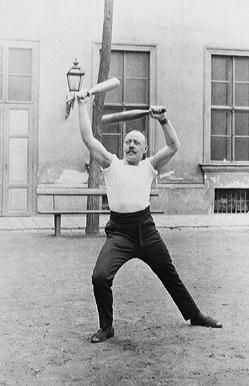Exercise
Resistance Training Brief History
September 12, 2025 – Frank Bills, PhD, CPT
A Brief History of Resistance Training in the US: “Old School” Before it Was Cool
The Barbell and Publishing Boom (Early 1900s)
If you step into a modern gym, it might seem that weightlifting has always been a regular part of fitness culture. Well, actually resistance training in the U.S. has been through a long and interesting journey—from 19th-century physical culture to its current position as a health and performance scientifically proven foundation.
Resistance training in the U.S. gained new momentum thanks to Alan Calvert, who in 1902 founded the Milo Bar-bell Company in Philadelphia, one of the first U.S. barbell manufacturers. He also launched Strength magazine in 1914—the first American periodical dedicated entirely to strength training.

Strongmen, Vaudeville, and Competitions
At the turn of the century, strength became both a sport and a spectacle. Al Treloar, an early American bodybuilder, worked alongside famed European strongman Eugen Sandow on the vaudeville circuit and later became physical director of the Los Angeles Athletic Club.
Meanwhile, Sandow’s 1901 London competition, The Greatest Show, helped establish bodybuilding as a legitimate public sport and art form, inspiring interest in the U.S.
Olympic Lifting and Competitive Platforms (Mid-20th Century)
By the 1940s and 1950s, weight training became more structured and competitive. Brothers Joe and Ben Weider co-founded the International Federation of Bodybuilders (IFBB) in 1946. Through their magazines, training methods, and events like Mr. America and Mr. Olympia, they propelled bodybuilding into the national spotlight.

The Golden Era of Bodybuilding (1960s–1970s)
Bodybuilding culture flourished on the U.S. West Coast, especially at Gold’s Gym in Santa Monica, where icons such as Arnold Schwarzenegger trained. Media exposure — including the documentary Pumping Iron (1977) — brought bodybuilding into the mainstream and made resistance training appealing to the general public.
Powerlifting and Elite Training (1980s–2000s)
The late 20th century saw the rise of powerlifting as its own sport. Innovators like Louie Simmons, founder of Westside Barbell, introduced training systems such as the conjugate method and equipment like the reverse hyperextension machine. His influence shaped elite powerlifting, football, and other sports training worldwide.
Social Dynamics and Fitness Mainstreaming
Resistance training has also mirrored broader cultural shifts. Historian Natalia Mehlman Petrzela notes that early fitness culture often reinforced exclusionary ideas about race, gender, and class. By the 1980s, however, public health campaigns and the women’s movement pushed the idea that everyone should exercise. Popular figures like Richard Simmons helped democratize fitness, making it more inclusive and accessible.
Resistance Training Today
Today, resistance training is no longer limited to athletes or bodybuilders. It is embraced across the lifespan for its role in preventing chronic disease, preserving mobility, and promoting strength and longevity. Its journey from niche spectacle to everyday health practice is one of the most significant cultural shifts in American fitness history.


Read more Blogs
Looking for more? Head back to the main blog page and explore the full library of posts.
